Getting To(wards) Know(ing) Together: An Innovative Collaborative Approach in Residential Care for People with (Severe) Intellectual Disabilities and Behaviour That Challenges
Abstract
1. Introduction
- (1)
- contribute to the quality of care and life for the protagonists, their relatives, and care staff, and
- (2)
- gain valuable insights for stagnant care practices elsewhere, as well as for the education of (future) care professionals.
2. Methodological Approach
2.1. Selection of Cases and Outsider-Researchers
2.2. Outsider-Researchers and How They Present Themselves, Protagonists and Insiders
2.2.1. Anne, Rian, and Insiders
2.2.2. Annemiek, Elisa, and Insiders
2.2.3. Boris, Ronald, and Insiders
2.2.4. Jan, Mark, and Insiders
2.2.5. Marcel, Özcan, and Insiders
2.2.6. Catrien, Özcan, and Insiders
2.2.7. Mark, Casper, and Insiders
2.2.8. Mats, Henk and Insiders
2.2.9. Peter, Raymond, and Insiders
2.2.10. Sanneke, Sandra, and Insiders
2.2.11. Nout, Henk and Insiders
2.2.12. Titus, Tamara, and Insiders
2.3. Preparation and Training of Outsider-Researchers
2.4. Design: A Multiple Case-Informed Community of Practice
2.5. Project Aim: Facilitating a Long-Term Exchange Between in- and Outsiders’ Perspectives
2.6. Positions Within the Academic Research Team
3. Epistemological Approach
3.1. ‘Getting to(wards) Know(ing) Together’
- Doing right by complexity and confusion, i.e., acknowledging the non-self-evident, and sometimes unsettling, character of interacting with other participants (verbally and non-verbally), thereby doing justice to the asymmetry, turmoil, and fluidity in learning to know each other [38,39]. In order words, we were very alert to identify and navigate any kind of resistance and conflict.
- Fundamental personal involvement, i.e., everyone involved was considered as a whole person, not merely on the basis of their (familiar) professional role or responsibility. Involvement from human to human, beyond formal divisions, fosters potential for new (inter)personal insights, developments, and challenges [36,40]. Therefore, we were attentive to everyone’s personal preferences, strengths, and weaknesses, for example by personalizing the research meetings and activities, and also by showing ongoing interest in personal issues and experiences.
- Experimenting within new contexts, i.e., in order to navigate the space for more fitting and sustainable ways to respond to each other in stagnant care practices, everyone involved was asked to commit to engaging in new ways and unfamiliar contexts [3,41]. That way, we aimed to stimulate learning and acting out of one’s comfort zone.
- Participants as source, means, and owner, i.e., addressing everyone’s emotions, values, and (professional and experiential) knowledge, in order to acknowledge and enable their contribution and belonging to this process of creating new knowledge [42,43]. Since we aimed for fitting and sustainable change, we strived to make everyone’s impact tangible, also for the sake of transferability (see Section 4.3). Creating particular, recognisable, and versatile multimedia materials (e.g., film, photo, exposition, poems, podcasts, illustrations, booklets) was part of this process. In doing so, we ultimately aimed to facilitate residents as well as their relatives and support staff in being understood, supported, and able to express themselves in more fitting and sustainable ways, beyond the involvement of the outsider-researcher.
- Slowing down, reflecting, adjusting, and holding on, i.e., everyone involved was regularly invited, in differing formations, to reflect together on the aims of our collaboration, and on the experienced potentials and pitfalls. Thus, we confronted participants with their own and others perspectives, performances, and impact. Thereby, we aimed to inquire and alter familiar patterns, which might entangle rather than untangle a stagnant care practice, also demanding profound and prolonged engagement from everyone involved [44,45].
3.2. Ongoing Demands of the Design: Keeping Everyone Receptive to Others’ Perspectives
4. Getting to(wards) Know(ing) Together: Collecting Data
4.1. ‘How to’ Getting to(wards) Know(ing) Together: Methodological Components and Phases
4.2. Data and Analysis of Our Approach and Process
4.3. Quality Criteria
5. Lessons Learned
5.1. Persevering Unease, Conflict and Loneliness Together Is Key
5.2. Creating Space for Difference Demands a Multilayered Approach
5.3. Exploring and Experimenting Within a Multilayered Community of Practice Offers Added Value
5.4. Attending to Unheard Voices Enables Insight and Change
‘This made Henk both special and very accessible, because we have all been young. I wanted to play with Henk as the little boy he is—a boy who can expend his energy, be mischievous, and explore boundaries. Together with two caregivers, we came up with two games, tested them, and refined them: blocks and a game made of sticks and balls—all in pink, the favourite colour of both Henk and me.’(outsider-researcher Mats)
‘Last night, I went for coffee with Henk at Suus’s home. We took the tandem bike and arrived there around 7:00 PM. We enjoyed sitting in the gazebo with Suus, and it was wonderful to see how relaxed Henk was and how much he was enjoying himself. Henk also mentioned several times that he felt relaxed and didn’t want to go home yet. Besides having a bonfire, we also roasted marshmallows. A little after 9:00 PM, we headed back home—not because Henk indicated that he wanted to, but because we eventually had to return home. Despite the stories that Henk is afraid of the dark, he actually enjoyed the streetlights, etc. Today, I […] gave Henk the space to process yesterday’s outing; sitting comfortably in his decorated garden, Henk had a lovely time reminiscing. Joi de vivre, long live Project WAVE!’(insider René, residence coordinator, email; see Figure 5)
5.5. Sustainable Multimedia Materials Foster Broader Involvement of Perspectives
‘Over the last two years, I did see Mark engaging with Casper, but then I was busy assisting the other residents and all. So it was only after watching the documentary he made about this, that I realised what he had been doing. […] The documentary illustrates what Mark coined as ‘time to-be-together’: a non-functional presence with Casper. After we watched the documentary, me and my colleagues agreed that we would try to embody this ‘time to-be-together’. Upon watching the documentary, to me the everyday meaning of Caspers hands was merely functional, or even negative. Functional, because I primarily hold his hands when I instruct him to do something; negative because Casper frequently uses his hands to grab and pinch whoever is near. Although I often also hold his hand as a sign of my presence during the daily walk, even then my main focus is on preventing behaviour that challenges: the grabbing and pinching of the person who assists him. His hands are always involved in those acts—as are mine, in order to hold him off or to disengage. So, my interpretation and meaning of the relation between his and my hands is strikingly different compared to the intimate image of the hand-in-hand interaction between Mark and Casper(see Figure 6)
It was that image that triggered me the most—and I was eager to try that too with Casper […] As soon as I moved my hand a little bit towards him and the mat, Casper reached to me with his hand. He started to stroke my hand, touch my fingers, fiddle with them. When I replied by imitating what he was doing, he started to grin. […] The first moment Casper touched my hand, I thought to myself: what’s he going to do next? I was very much committed to this being and staying a positive encounter, for both of us. I did not want this touching to turn into pitching; it had to stay good. Casper making positive contact with me with his hands was magnificent. I had not expected it to go so fast—that he would reach out to me like that with his hands, in this setting, and that it would be so pleasant. Sitting beside him without touching would have been fine already. I wanted it to be his decision, since we as staff determine so many things in his everyday life already. I didn’t know that touching hands with him could be positive and non-functional. What I felt in those 4 minutes next to Casper on the doormat? That was good, that was extremely positive. That I, with so little, could have such a successful experience with him, overwhelmed me. It was so easy!’(insider Tonny, residential support worker; the complete blog is accessible via the Appendix A)
6. Discussion
- (1)
- in order to facilitate a structural place for alternative perspectives within stagnant complex care practices, building a multilayered community of practice around cases is vital, and
- (2)
- this type of collaborative design is needed to improve the often struggling and instable support services for people with M/S ID whose behaviours challenge.
7. Conclusions
Author Contributions
Funding
Institutional Review Board Statement
Informed Consent Statement
Data Availability Statement
Acknowledgments
Conflicts of Interest
Abbreviations
| M/S ID | moderate to severe intellectual disabilities |
| BPSW | Professional association for primary care workers [Dutch: Beroepsvereniging voor professionals in sociaal werk] |
| CCE | Centre for Consultation and Expertise |
Appendix A
References
- Tossebro, J.; Bonfils, I.; Teittinene, A.; Tideman, M.; Traustadottir, R.; Vesala, H.T. Normalization fifty years beyond current trends in the Nordic countries. J. Policy Pract. Intellect. Disabil. 2012, 9, 134–146. [Google Scholar] [CrossRef]
- Clifford Simplican, S. Behaviours that challenge disability studies. Disabil. Soc. 2019, 34, 1379–1398. [Google Scholar] [CrossRef]
- Bos, G.F. Antwoorden op andersheid. Over Ontmoetingen Tussen Mensen Met En Zonder Verstandelijke Beperking in Omgekeerde-Integratiesettingen. Ph.D. Thesis, VU University, Amsterdam, The Netherlands, 26 January 2016. Available online: https://hdl.handle.net/1871/53873 (accessed on 26 August 2025).
- Emerson, E. Challenging Behaviour: Analysis and Intervention in People with Severe Intellectual Disabilities, 2nd ed.; University Press: Cambridge, UK, 2001. [Google Scholar]
- Olivier-Pijpers, V.C.; Cramm, J.M.; Nieboer, A.P. Residents’ and resident representatives’ perspectives on the influence of the organisational environment on challenging behaviour. Res. Dev. Disabil. 2020, 100, 103629. [Google Scholar] [CrossRef] [PubMed]
- Emerson, E.; Einfeld, S.L. Challenging Behaviour, 3rd ed.; University Press: Cambridge, UK, 2011. [Google Scholar]
- Kamstra, A.; van der Putten, A.A.J.; Vlaskamp, C. The structure of informal social networks of persons with profound intellectual and multiple disabilities. J. Appl. Res. Intellect. Disabil. 2015, 28, 249–256. [Google Scholar] [CrossRef]
- Van Asselt-Goverts, A.E.; Embregts, P.J.C.M.; Hendriks, A.H.C. Social networks of people with mild intellectual disabilities: Characteristics, satisfaction, wishes and quality of life. J. Intellect. Disabil. Res. 2015, 59, 450–461. [Google Scholar] [CrossRef]
- Willems, A.P.; Embregts, P.J.; Bosman, A.M.; Hendriks, A.H. The analysis of challenging relations: Influences on interactive behaviour of staff towards clients with intellectual disabilities. J. Intellect. Disabil. Res. 2014, 58, 1072–1082. [Google Scholar] [CrossRef]
- Mansell, J.; Beadle-Brown, J. Active Support: Enabling and Empowering People with Intellectual Disabilities; Jessica Kingsley: London, UK, 2012. [Google Scholar]
- Tournier, T.; Hendriks, A.H.C.; Jahoda, A.; Hastings, R.P.; Embregts, P.J. Developing a logic model for the Triple-C intervention: A practice-derived intervention to support people with intellectual disability and challenging behaviour. J. Policy Pract. Intellect. Disabil. 2020, 17, 297–307. [Google Scholar] [CrossRef]
- Carr, E.G.; Dunlap, G.; Horner, R.H.; Koegel, R.L.; Turnbull, A.P.; Sailor, W.; Anderson, J.L.; Albin, R.W.; Kern Koegel, L.; Fox, L. Positive Behaviour Support: Evolution of an applied science. J. Posit. Behav. Interv. 2002, 4, 4–16. [Google Scholar] [CrossRef]
- Gore, N.J.; McGill, P.; Toogood, S.; Allen, D.; Hughes, J.C.; Baker, P.; Hastings, R.P.; Noone, S.J.; Denne, L.D. Definition and scope of Positive Behavioural Support. IJPBS 2013, 3, 14–23. Available online: https://www.bild.org.uk/wp-content/uploads/2020/01/Definition-and-scope-for-positive-behavioural-support.pdf. (accessed on 26 August 2025).
- Hendrikse, B. (Ed.) Zelfverwonding. In Een Interdisciplinaire Aanpak van Ernstig en Aanhoudend Zelfverwondend Gedrag bij Mensen met een Matige Tot Zeer Ernstige Verstandelijke Beperking; Centrum voor Consultatie en Expertise: Utrecht, The Netherlands, 2017; Available online: https://cce.nl/sites/cce.nl/files/2021-01/CCE_Publicatie%20Zelfverwonding_Interactief.pdf (accessed on 26 August 2025).
- Kolen, M. De Ongekende Mogelijkheid van Het Alledaagse. Een Kwalitatief-Empirische, Zorgethische Studie Naar Morele Betekenissen in de Alledaagse Omgang Tussen Jongeren Met Een Licht Verstandelijke Beperking en Zorgprofessionals. Ph.D. Thesis, University of Humanistic Studies, Utrecht, The Netherlands, 3 November 2017. Available online: https://research.uvh.nl/files/14764951/Full%20Text.pdf (accessed on 29 August 2025).
- Beck, U. Risk Society: Towards a New Modernity; Ritter, T.M., Ed.; SAGE: London, UK; Thousand Oaks, CA, USA; New Delhi, India, 2000. [Google Scholar]
- Niemeijer, A.R. Exploring Good Care with Surveillance Technology in Residential Care for Vulnerable People. Ph.D. Thesis, VU University, Amsterdam, The Netherlands, 28 January 2015. Available online: https://hdl.handle.net/1871/52244 (accessed on 29 August 2025).
- Mans, I. Het Hart van de Zorg. Idealen en Praktijken in de Verstandelijk Gehandicaptenzorg Bij de Hafakker (1960–2010); Papieren Tijger: Breda, The Netherlands, 2017. [Google Scholar]
- Griffith, G.M.; Hutchinson, L.; Hastings, R.P. ‘I’m not a patient, I’m a person’: The experiences of individuals with intellectual disabilities and challenging behaviour—A thematic synthesis of qualitative studies. Clin. Psychol. Sci. Pract. 2013, 20, 469–488. [Google Scholar] [CrossRef]
- Bowring, D.L.; Painter, J.; Hastings, R.P. Prevalence of challenging behaviour in adults with intellectual disabilities, correlates, and association with mental health. Curr. Dev. Disord. Rep. 2019, 6, 173–181. [Google Scholar] [CrossRef]
- Olivier-Pijpers, V.C.; Cramm, J.M.; Nieboer, A.P. Cross-sectional investigation of relationships between the organisational environment and challenging behaviours in support services for residents with intellectual disabilities. Heliyon 2020, 6, e04751. [Google Scholar] [CrossRef]
- Griffith, G.M.; Hastings, R.P. ‘He’s hard work, but he’s worth it’. The experience of caregivers of individuals with intellectual disabilities and challenging behaviour: A meta-synthesis of qualitative research. J. Appl. Res. Intellect. Disabil. 2014, 27, 401–419. [Google Scholar] [CrossRef] [PubMed]
- Ngozi Adichie, C. The Danger of a Single Story. TED Global. Available online: https://www.ted.com/talks/chimamanda_ngozi_adichie_the_danger_of_a_single_story?language=en (accessed on 30 May 2025).
- Van Goidsenhoven, L. OnGehoord: Over Kleine Interacties Wanneer Woorden Niet Vanzelfsprekend Zijn; EPO: Antwerpen, Belgium, 2021. [Google Scholar]
- Letiche, H. Polyphony and its Other. Organ. Stud. 2010, 31, 261–277. [Google Scholar] [CrossRef]
- Von Peter, S.; Bos, G.F. The necessity of unsettling encounters in collaborative research: Reflections of two researchers without experiential expertise. Collaborations 2022, 5, 1–15. [Google Scholar] [CrossRef]
- Bengesai, A. Outsiders Looking in: Tutor Expertise in Engineering Writing. Afr. J. Res. Math. Sci. Technol. Educ. 2015, 19, 95–104. [Google Scholar] [CrossRef]
- Bos, G.F.; Olivier-Pijpers, V.C.; Niemeijer, A.R. Interweaving outsiders’, professionals’ and relatives’ perspectives in stagnant care practices. 2025, submitted.
- Olivier-Pijpers, V.C.; Landman, W. Bewegen bij Probleemgedrag. Een (Actie)Onderzoek Naar Organisatiecontext bij Het Vastlopen en in Beweging Krijgen van Situaties van Probleemgedrag. Centrum Voor Consulstatie en Expertise 2020. Available online: https://cce.nl/sites/cce.nl/files/documents/200612_interactieve_pdf_publicatie_bewegen_bij_probleemgedrag.pdf (accessed on 29 August 2025).
- Grace, J.; Nind, M.; de Haas, C.; Hope, J. Expanding Possibilities for Inclusive Research: Learning from People with Profound Intellectual and Multiple Disabilities and Decolonising Research. Soc. Sci. 2024, 13, 37. [Google Scholar] [CrossRef]
- Kunneman, H.P.J.M. Van Theemutscultuur Naar Walkman-Ego: Contouren van Een Postmoderne Individualiteit; Boom: Amsterdam/Meppel, The Netherlands, 1996. [Google Scholar]
- Wenger, E. Communities of Practice: Learning, Meaning, and Identity; Cambridge University Press: Cambridge, UK, 1998. [Google Scholar]
- Wenger-Trayner, E.; Wenger-Trayner, B. Learning to Make a Difference: Value Creation in Social Learning Spaces; Cambridge University Press: Cambridge, UK, 2020. [Google Scholar]
- Askins, K. Feminist geographies and participatory action research: Co-producing narratives with people and place. Gend. Place Cult. 2018, 25, 1277–1294. [Google Scholar] [CrossRef]
- Brown, B. Daring Greatly: How the Courage to be Vulnerable Transforms the Way We Live, Love, Parent and Lead; Penguin Books Ltd.: London, UK, 2015. [Google Scholar]
- Neath, N.; McCluskey, U. To be Met as a Person at Work: The Effect of Early Attachment Experiences on Work Relationships; Routledge: Abingdon, UK; New York, NY, USA, 2019. [Google Scholar]
- Bos, G.F.; Kal, D.; Abma, T.A.; Tromp, T. Werken aan nieuwe ontmoetingen in de marge. NTZ. Ned. Tijdschr. Voor De Zorg Aan Mensen Met Een Verstand. Beperking 2019, 45, 235–254. [Google Scholar]
- Clifford Simplican, S.; Leader, G. Counting inclusion with Chantal Mouffe: A radical democratic approach to intellectual disability research. Disabil. Soc. 2015, 30, 717–730. [Google Scholar] [CrossRef]
- Kunneman, H. Amor Complexitatis. Bouwstenen voor Kritisch Humanisme—Deel 2; SWP: Amsterdam, The Netherlands, 2017. [Google Scholar]
- Church, K. Forbidden Narratives: Critical Autobiography as Social Science; Theory and Practice in Medical Anthropology and International Health; Routledge: Abingdon, UK, 1995; Volume 2. [Google Scholar]
- Visker, R. Lof der Zichtbaarheid. Een Uitleiding in de Hedendaagse Wijsbegeerte; SUN: Nijmegen, The Netherlands, 2007. [Google Scholar]
- Brannelly, T.; Barnes, M. Researching with Care: Applying Feminist Care Ethics to Research Practice; Policy Press: Bristol, UK, 2022. [Google Scholar]
- Wakeford, T.; Sanchez Rodriguez, J. Participatory action research: Towards a more fruitful knowledge. In Connected Communities Foundation Series; Facer, L., Dunleavy, K., Eds.; University of Bristol/AHRC Connected Communities Programme: Bristol, UK, 2018. [Google Scholar]
- Brons, R. Waardenwerk Voor de Strijdigheid van Het Bestaan. Waardenwerk 2014, 57, 72–84. [Google Scholar]
- Lyotard, J.-F. The Differend: Phrases in Dispute; Van den Abbeele, G., Translator; University of Minnesota Press: Minneapolis, MN, USA, 1983/1988. [Google Scholar]
- Knotter, M.H. The Whole is More: A Contextual Perspective on Attitudes and Reactions of Staff Towards Aggressive Behaviour of Clients with ID in Residential Institutions. Ph.D. Thesis, University of Amsterdam, Amsterdam, The Netherlands, 1 February 2019. Available online: https://hdl.handle.net/11245.1/f83c5937-a47a-4b75-8cb3-924a35bc3199 (accessed on 26 August 2025).
- Mertens, D. Transformative Research and Evaluation; Guildford Press: New York, NY, USA; London, UK, 2009; pp. 1–21. [Google Scholar]
- Visse, M.; Hansen, F.; Leget, C. The Unsayable in Arts-Based Research: On the Praxis of Life Itself. Int. J. Qual. Methods 2019, 18, 1609406919851392. [Google Scholar] [CrossRef]
- Bellersen, M.; Kohlmann, I. Praktijkboek Intervisie, Proces & Methoden; Practical Guide intervision, process & methods; Boom Publishers: Amsterdam, The Netherlands, 2012. [Google Scholar]
- Abma, T.A.; Banks, S.; Cook, T.; Dias, S.; Madsen, W.; Springett, J.; Wright, M.T. Participatory Research for Health and Social Well-Being; Springer: Dordrecht, The Netherlands, 2019. [Google Scholar]
- Guba, E.G.; Lincoln, Y.S. Fourth Generation Evaluation; Sage: Beverly Hills, CA, USA, 1989. [Google Scholar]
- Creswell, J.W.; Poth, C.N. Qualitative Inquiry & Research Design: Choosing Among Five Approaches. Sage Publications: Beverly Hills, CA, USA, 2017. [Google Scholar]
- Lincoln, Y.S.; Guba, E.G. But is it rigorous? Trustworthiness and Authenticity in Naturalistic Evaluation. In Naturalistic Evaluation: New Directions for Program Evaluation; Williams, D.D., Ed.; Jossey-Bass: San Francisco, CA, USA, 1986; pp. 73–84. [Google Scholar] [CrossRef]
- Adeagbo, M.J. An ‘outsider within’: Considering positionality and reflexivity in research on HIV-positive adolescent mothers in South Africa. Qual. Res. 2020, 21, 181–194. [Google Scholar] [CrossRef]
- McGee, J.J. Gentle Teaching: A Non-Aversive Approach to Helping Persons with Mental Retardation; Human Sciences Press: New York, NY, USA, 1987. [Google Scholar]
- Bos, G.F.; Abma, T.A. Putting down verbal and cognitive weaponry: The need for ‘experimental-relational spaces of encounter’ between people with and without severe intellectual disabilities. Disabil. Soc. 2021, 37, 1703–1727. [Google Scholar] [CrossRef]
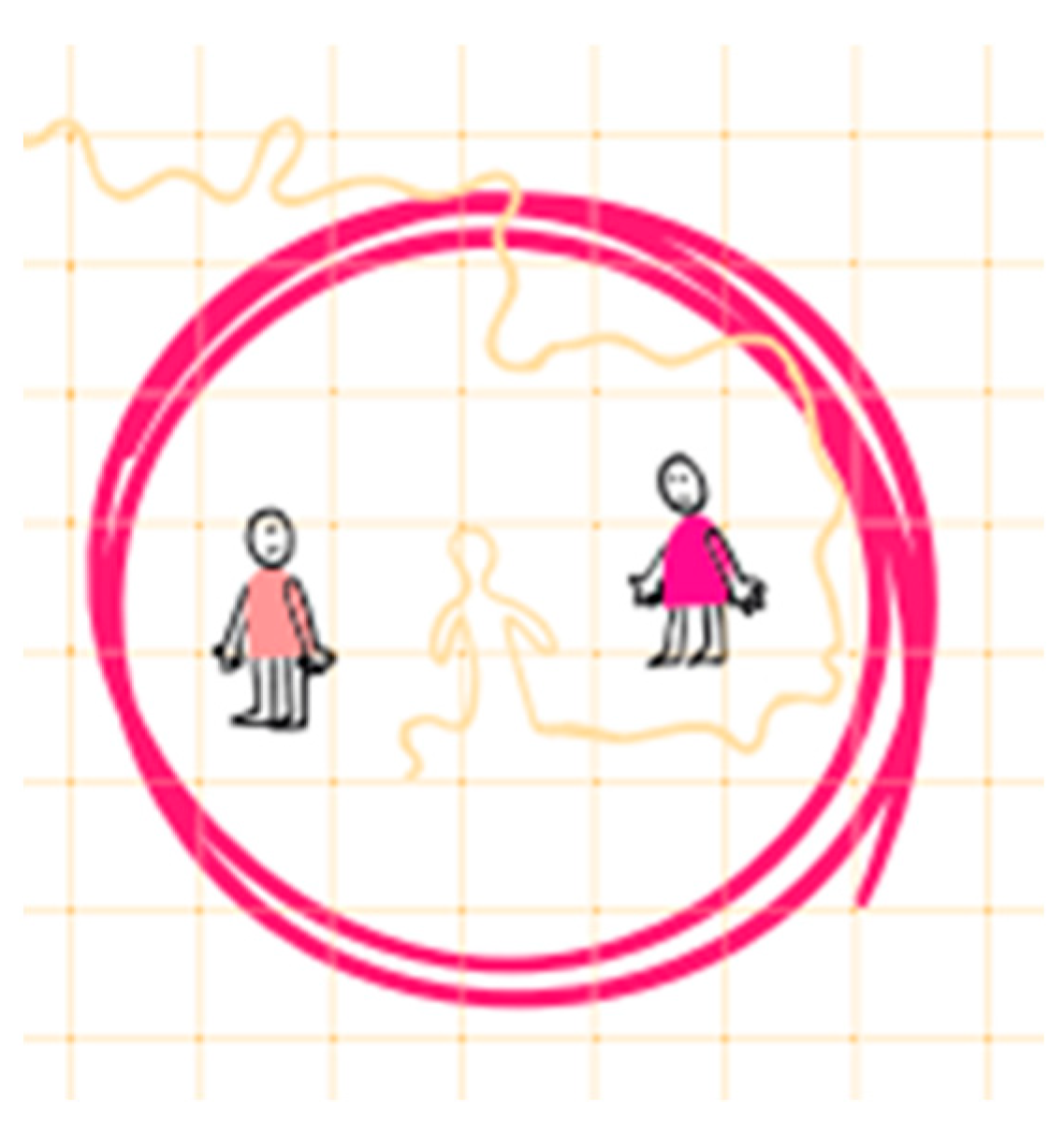
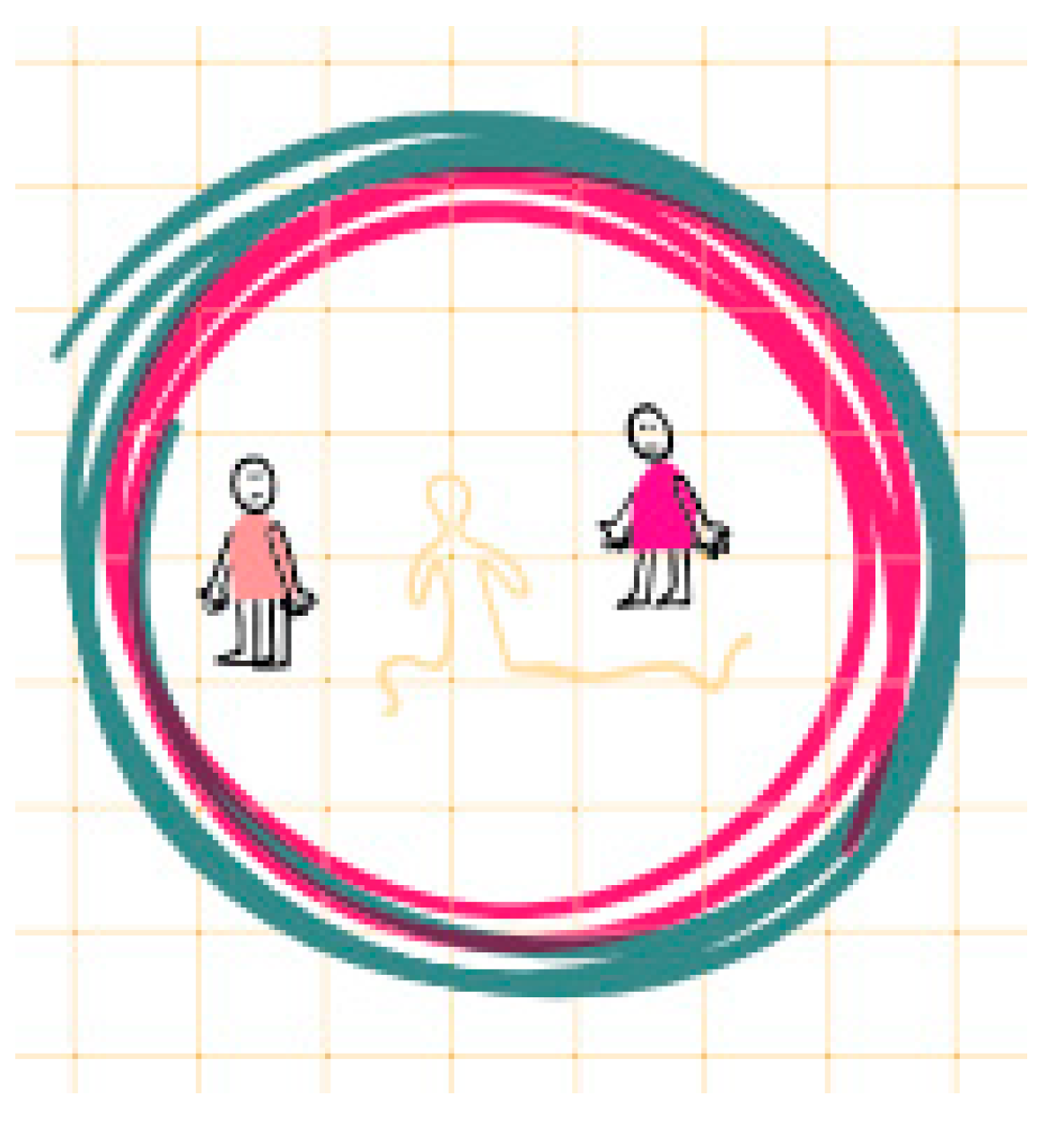

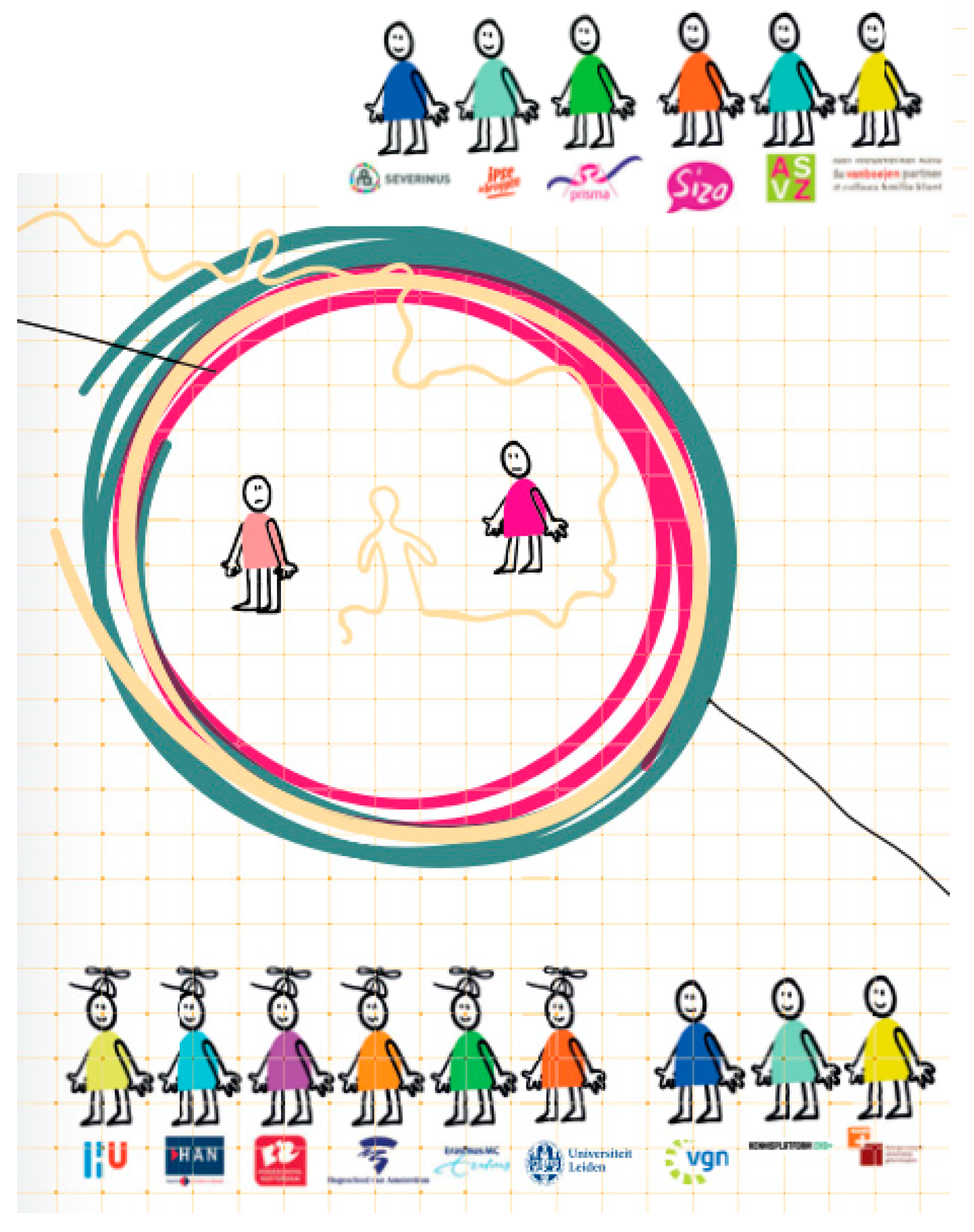
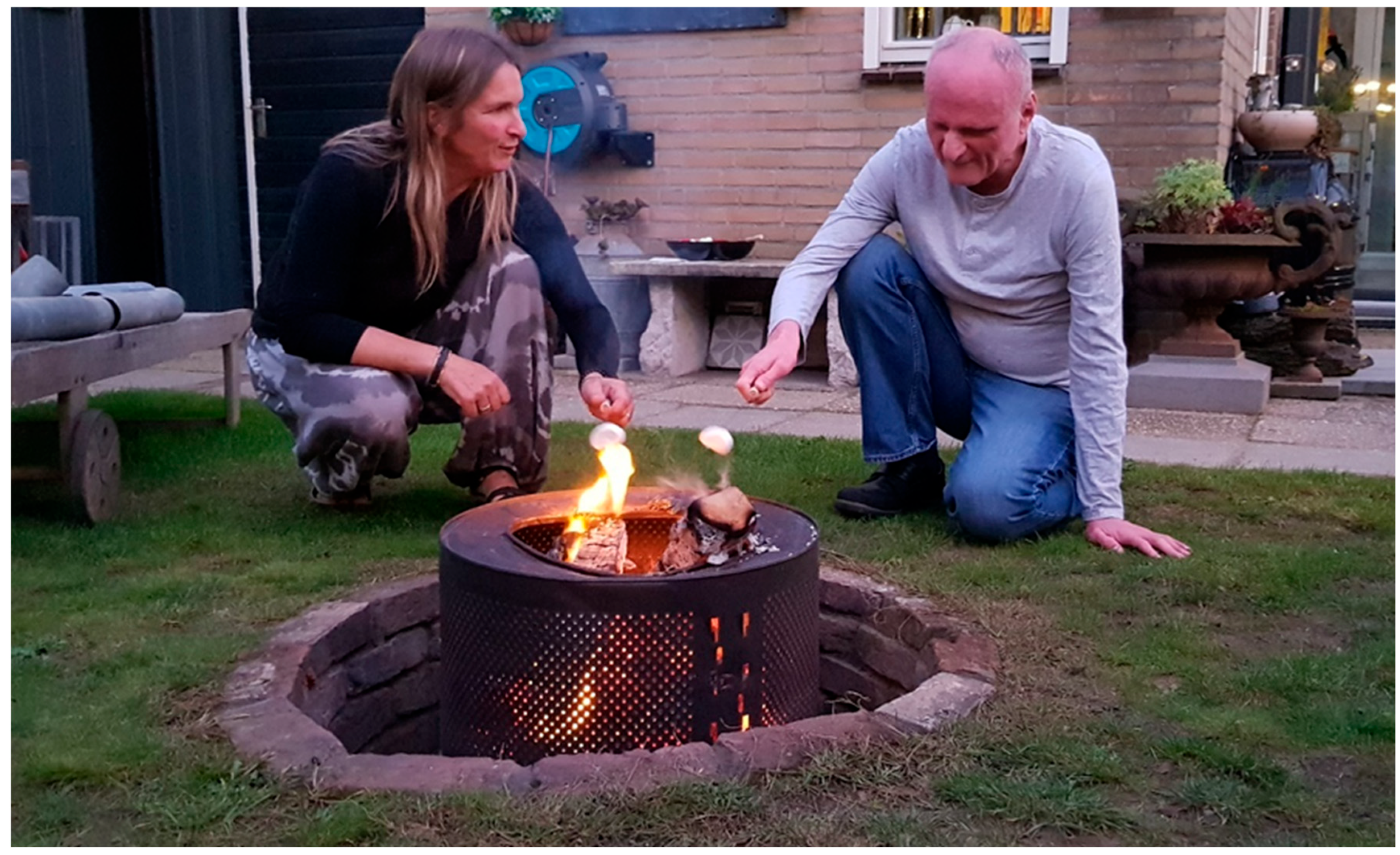
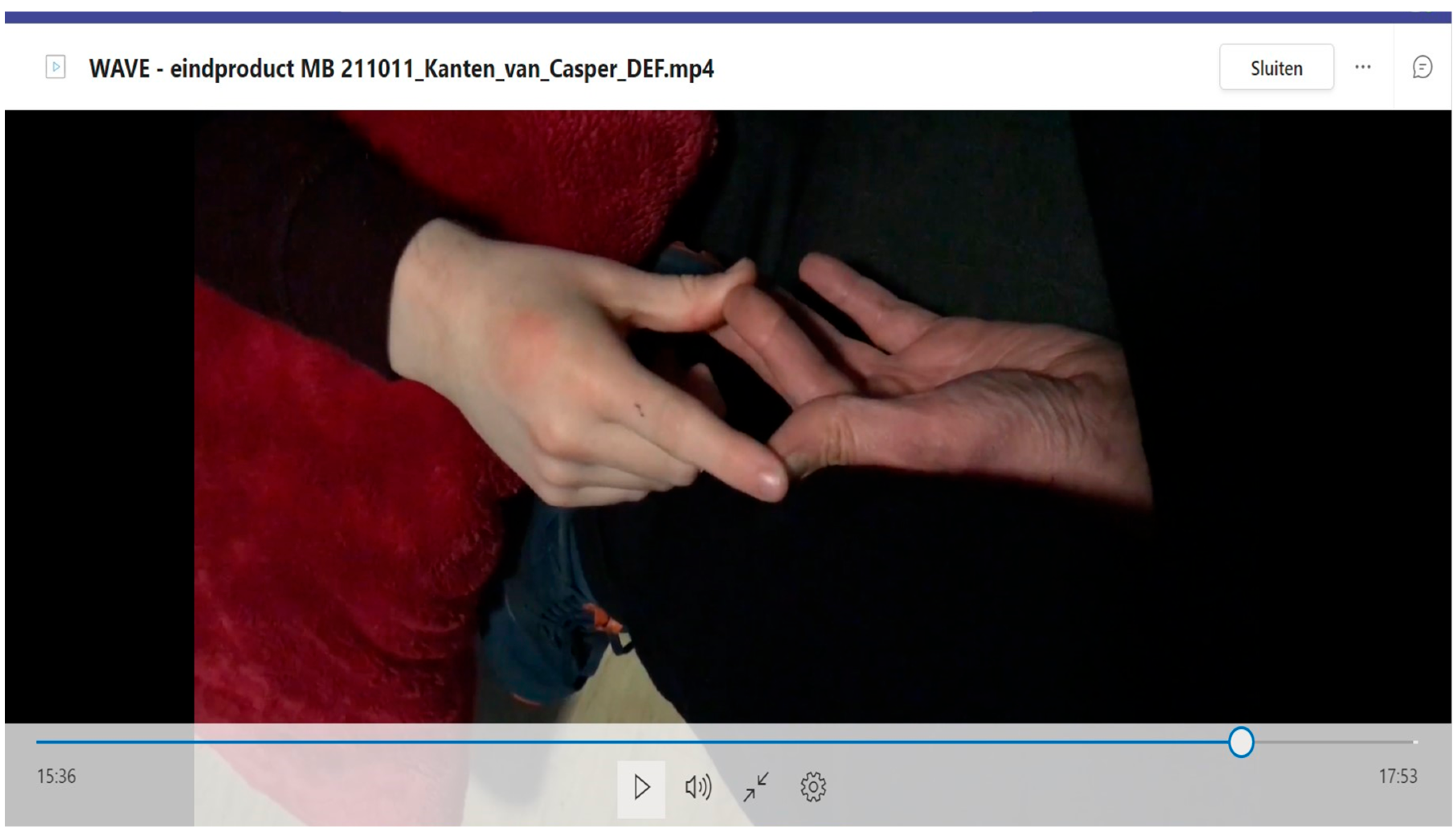
| Phase | Actual Timeline | Year | Months | Methodological Components |
|---|---|---|---|---|
| 1 | December 2019–May 2020 | 1 | 1–6 | Observing, cautious initial acquaintance (i.e., participant observation, reflection) |
| 2 | June 2020 | 7 | Initial feedback reflections in exchange meeting per case (i.e., reflection, dialogue, analysis) | |
| 3 | June–November 2020 | 7–12 | Further acquaintance, first outer circle meeting (i.e., participant observation, reflection, dialogue, analysis) | |
| 4 | November 2020–March 2021 | 2 | 12–16 | Interim imaging, contact from a distance and/or returning inside (due to COVID measures), second outer circle meeting (i.e., reflection, imagination, dialogue, analysis) |
| 5 | March–July 2021 | 16–20 | Persisting or perishing (turmoil, unease, conflicts, and loneliness); establishing core teams per case; third outer circle meeting (i.e., dialogue, reflection, analysis) | |
| 6 | July–November 2021 | 3 | 20–24 | Trying out, embodying and embedding new ways of thinking and doing (i.e., imagination, experimentation, reflection, dialogue, analysis) |
| 7 | November 2021–May 2022 | 24–30 | Reflecting on contributions and impact of outsider-researchers; presentation of final products/insights; fourth outer circle meeting (i.e., dialogue, reflection, analysis) | |
| 8 | May–November 2022 | 30–36 | Farewell as outsider-researchers, organisation-specific meetings; fifth (and final) outer circle meeting (i.e., dialogue, reflection, analysis) | |
| 9 | November 2022–now | >3 | beyond 36 | Sharing findings via project website, traveling exhibition, learning module and continuation of the community of practice for the next four years (2023–2026) (i.e., dialogue, reflection, analysis) |
Disclaimer/Publisher’s Note: The statements, opinions and data contained in all publications are solely those of the individual author(s) and contributor(s) and not of MDPI and/or the editor(s). MDPI and/or the editor(s) disclaim responsibility for any injury to people or property resulting from any ideas, methods, instructions or products referred to in the content. |
© 2025 by the authors. Licensee MDPI, Basel, Switzerland. This article is an open access article distributed under the terms and conditions of the Creative Commons Attribution (CC BY) license (https://creativecommons.org/licenses/by/4.0/).
Share and Cite
Bos, G.F.; Olivier-Pijpers, V.C.; Niemeijer, A.R. Getting To(wards) Know(ing) Together: An Innovative Collaborative Approach in Residential Care for People with (Severe) Intellectual Disabilities and Behaviour That Challenges. Int. J. Environ. Res. Public Health 2025, 22, 1368. https://doi.org/10.3390/ijerph22091368
Bos GF, Olivier-Pijpers VC, Niemeijer AR. Getting To(wards) Know(ing) Together: An Innovative Collaborative Approach in Residential Care for People with (Severe) Intellectual Disabilities and Behaviour That Challenges. International Journal of Environmental Research and Public Health. 2025; 22(9):1368. https://doi.org/10.3390/ijerph22091368
Chicago/Turabian StyleBos, Gustaaf F., Vanessa C. Olivier-Pijpers, and Alistair R. Niemeijer. 2025. "Getting To(wards) Know(ing) Together: An Innovative Collaborative Approach in Residential Care for People with (Severe) Intellectual Disabilities and Behaviour That Challenges" International Journal of Environmental Research and Public Health 22, no. 9: 1368. https://doi.org/10.3390/ijerph22091368
APA StyleBos, G. F., Olivier-Pijpers, V. C., & Niemeijer, A. R. (2025). Getting To(wards) Know(ing) Together: An Innovative Collaborative Approach in Residential Care for People with (Severe) Intellectual Disabilities and Behaviour That Challenges. International Journal of Environmental Research and Public Health, 22(9), 1368. https://doi.org/10.3390/ijerph22091368






